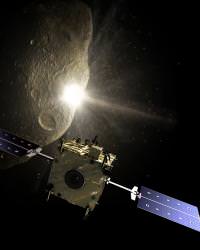You know the cliche: it’s not a question of if an asteroid will strike the Earth, it’s a question of when. Why wait for the asteroid impact, let’s get out there and learn how to prevent an impact in the first place. Part of this learning process will be to study potential Earth-crossing asteroids in great detail. ESA has just such a mission in the works: Don Quijote.
There are several problems with asteroids. For starters, we don’t even know where they all are. But even when we discover their locations and plot out their orbits, it’s all game of probabilities. Over time, asteroids interact with other objects, and their orbits get changed in ways which are hard to predict. Not only that, but sunlight heats up asteroids in ways that can give them a tiny thrust, so they can change their orbits all on their own.
Astronomers are working hard to catalog all the asteroids out there; automated surveys should find most of the objects larger than 140 metres (460 feet) by about 2020. But plotting out their exact positions, and thus their future trajectories, is the hard part.
So Europe is planning to reach out and tag an asteroid. With a homing beacon, an asteroid will be much easier to track as it moves across the Solar System.
The mission is called Don Quijote, and it will work in two phases. The first phase will consist of an orbiter which will rendezvous with an asteroid and begin circling it. It will monitor the asteroid for several months, studying its size, shape, mass and gravity field.
In the second stage, an impactor spacecraft would slam into the asteroid at a speed of 10 km/s, which the first spacecraft watches – sort of like what happened with Deep Impact. The orbiter could then study the asteroid again, seeing what changed. Ground observers could also make precise measurements on the asteroid’s orbit and determine how its trajectory changed from the impact.
ESA doesn’t have a specific asteroid in mind, but they’re seriously considering a space rock called Apophis, which will come dangerously close to the Earth in the future.
If the mission is approved, it could launch early in the next decade, and take about 25 months to fly to its target. Maybe then we’ll get a much better handle on potentially dangerous asteroids, and learn everything we need to know to prevent them.
Original Source: ESA News Release

